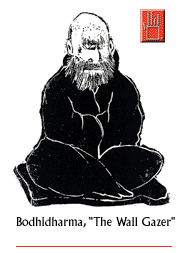On The Way: The Daily Zen Journal
Sayings of Master Rujing of Tiantong
Rujing (1163-1228)
Although saints and self-enlightened sages do not become attached to their experience in sitting meditation, they lack great compassion, therefore, they are not the same as the buddhas and patriarchs, who considered great compassion foremost and sat in meditation with the vow to save all sentient beings.
The outsiders in India also sat in meditation, but they always had three problems; attachment to the experience, false views, and, conceit—therefore it is always different from the sitting meditation of the buddhas and patriarchs.
Buddhist disciples also had sitting meditation, but their compassion was weak; they did not penetrate the real character of all things with incisive knowledge—only improving themselves, they cut off the lineage of the buddhas; therefore theirs is always different from the sitting meditation of buddhas and patriarchs.
What I mean to say is that buddhas and patriarchs, from their very first inspiration, sit in meditation with the vow to gather together all the qualities of buddhahood; therefore in their sitting meditation they do not forget sentient beings, do not forsake sentient beings – they always have loving thoughts even for insects and vow to rescue them.
Whatever virtues they have, they dedicate to all; therefore the buddhas and patriarchs are always in the world of desire practicing meditation and working on the way. In the world of desire only this world provides the best situation. Cultivating all virtues one attains to gentility and ease of mind.
Rujing (1163-1228)

What to be aware of in zazen, sitting meditation
Keizan Jokin (1264-1325)
If you want to sit in meditation, first find a quiet place and spread a thick mat for comfortable sitting. Do not let wind or smoke, rain or dew in. Keep a clear place to sit, with enough room for your knees. Although there were people who sat on diamond seats or boulders in ancient times, they all had sitting cushions.
When sitting in zazen your body may seem hot or cold, uneasy or comfortable, sometimes stiff, sometimes loose, sometimes heavy, sometimes light, sometimes startled awake. This is all because the breath is not in tune and needs to be tuned.
The way of tuning the breath is as follows: open your mouth, letting the breath be long or short, gradually harmonize it. Follow the breath for a while; a sense of awareness will come and then the breath is in good tune. After that let the breath pass naturally through the nose.
You may sit with legs crossed or underneath you. Loosen your clothes and straighten them. Place your right hand on your left foot and your left hand on your right hand, with your thumbs together near the body about the level of tanden – about 2 inches below the navel.
Sit up straight, without leaning to the left or the right, front or back. The ears and shoulders, nose and navel should be aligned. The tongue is kept on the roof of the mouth, and the breath should pass through the nose.
The mouth should be closed, while the eyes should be open, though not too widely, or too slightly. Having attuned your body in this way, breathe deeply through the mouth a couple of times. Next, sitting steady, sway your body seven or eight times, going from larger to smaller movements. Then sit upright and intent.
Cast off mind, intellect, and consciousness. Cease recollection, thought, and observation. Don’t aim at becoming a buddha, don’t be concerned with right or wrong; value time as though saving your head from burning. The Buddha sat upright, Bodhidharma faced a wall, single-minded, without any other concerns at all. Shishuang was like a dead tree.
Rujing admonished against sleeping while sitting. “You can only succeed by just sitting, without need to make use of burning incense, prostration, remembrance of buddha names, repentance ceremonies, reading scriptures or ritual recitations,” said Rujing.
Always abide in great compassion, and dedicate the boundless power of sitting meditation to all living beings. Don’t become proud, conceited, or self righteous – these are qualities of ordinary people.
Just sitting, not doing anything at all, is the essential technique for penetrating zen. With body and mind at ease, behavior harmonious, abandon worldly feelings and don’t cling to feelings of the way.
Recorded by Keizan Jokin (1264-1325)
Excerpted from Timeless Spring: A Soto Zen Anthology, Thomas Cleary



Rujing lived from 1163-1228 and served as abbot of several large monasteries. It was at Tiantong in eastern China that Dogen met Rujing, who was to become the greatest spiritual benefactor of Dogen. It was he who taught Dogen the technique of “just sitting.” The above excerpt was taken from Dogen’s record of private talks with Rujing.
This summer we return to the basics of practice – meditation. With practice meditation is one doorway students can experience first hand Blue Sky Mind – that unpressured and yet aware, miraculously aware mind.
Once this foundation is established in sitting we have a benchmark to return to in daily life and in interactions with others. At some point in training a true turn-about occurs where the unpressured, empty boat experience feels more like home than the compulsive, selfish and reactive mind of before.
We will be spending time with this foundation and find the common thread as taught by many teachers of old that sings through the modern teachings of today. This is our summer retreat.
Describing a circle in the air, Dogen said, “This is an immeasurably great matter: all the enlightened ones of the past, present, and future comprehend this, the successive generations of ancestral teachers realized this, people searching out the way investigate this. If you can get it in your daily activities, you will actually go a step beyond the enlightened ancestors.”
Warmly,
Elana, Scribe for Daily Zen